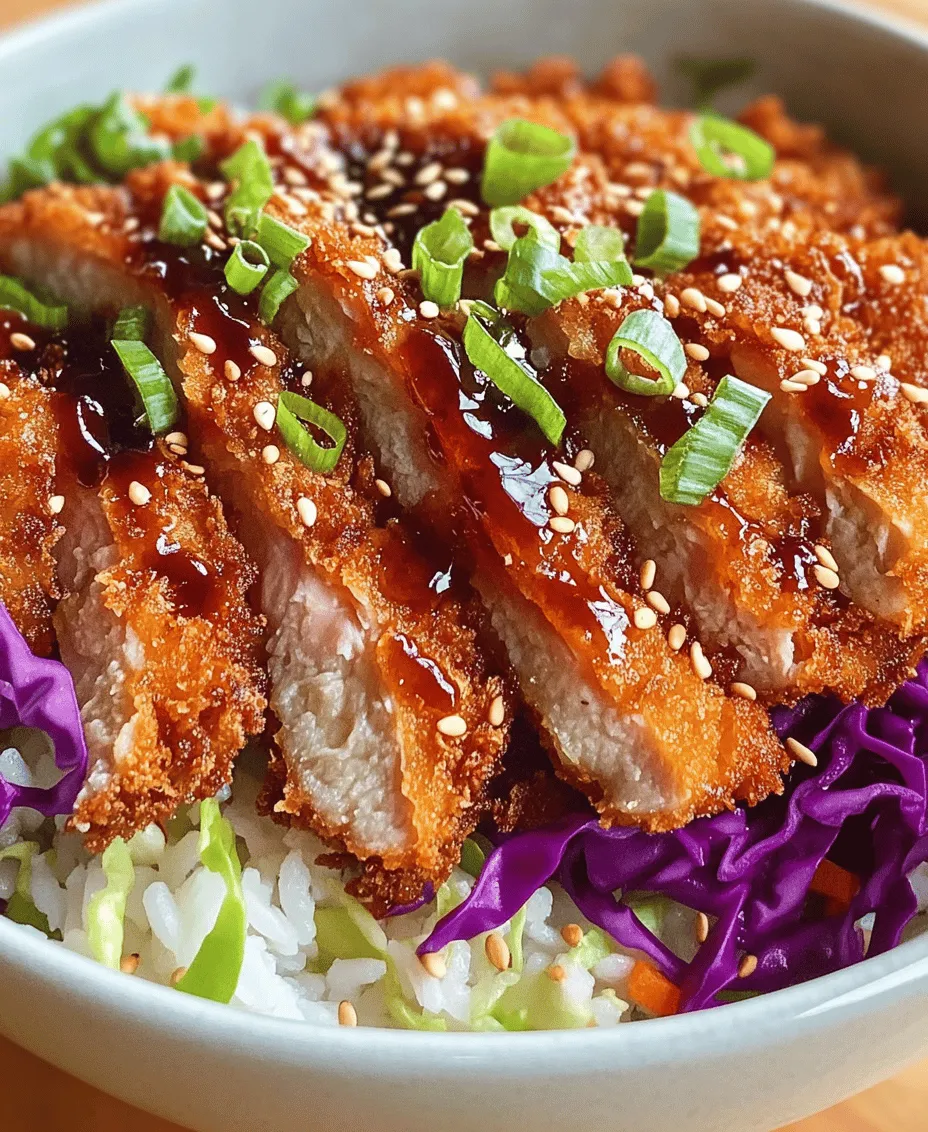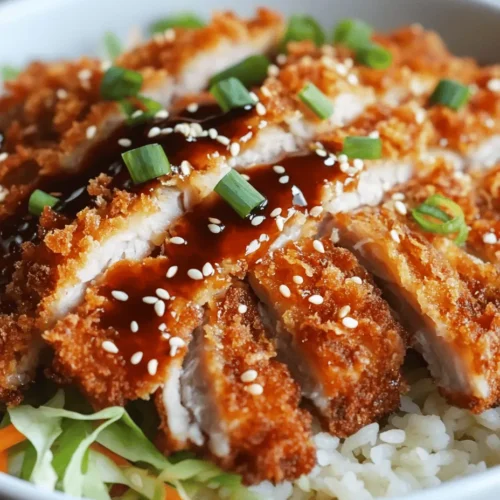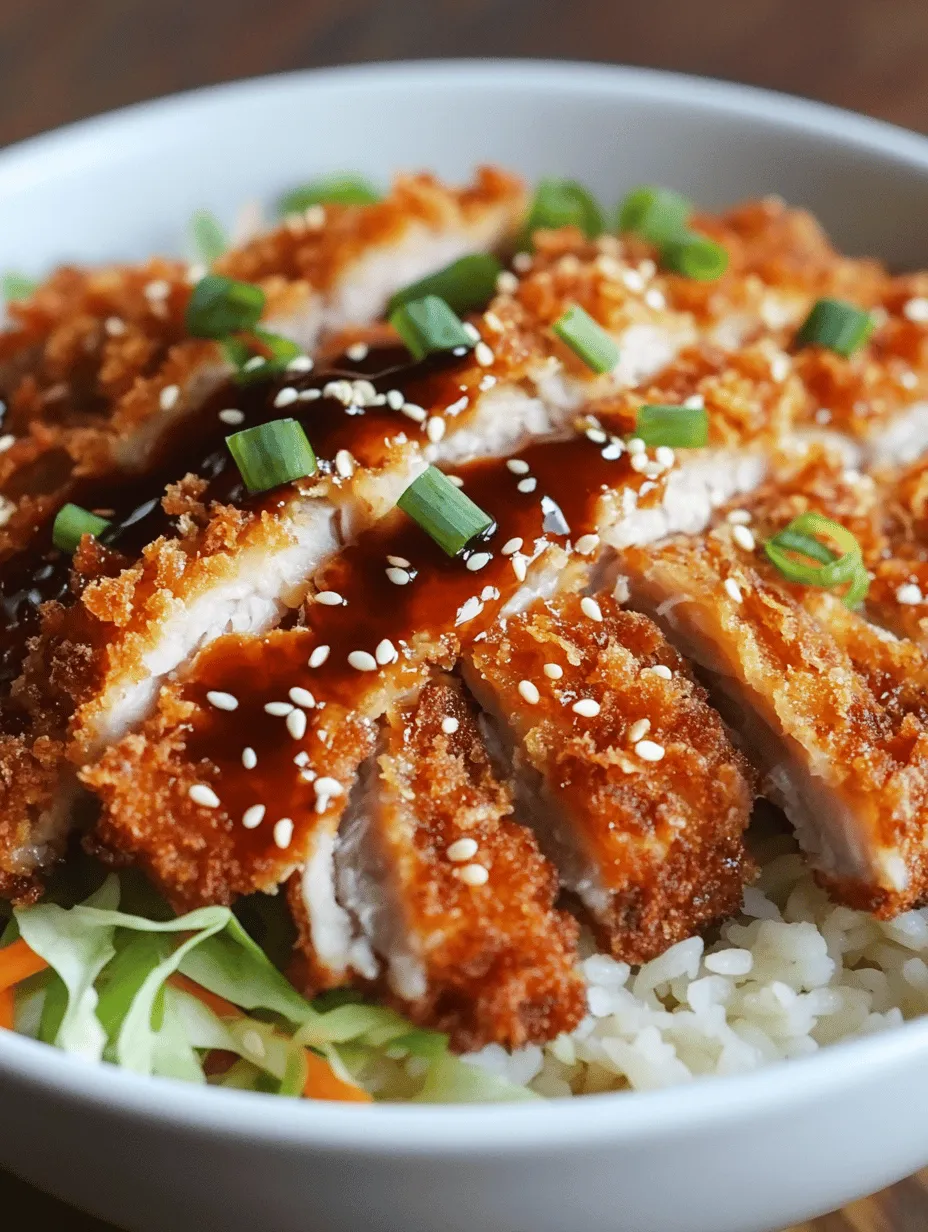Japanese cuisine is renowned for its exquisite flavors, meticulous presentation, and harmonious balance of textures. Among its many culinary treasures, one dish stands out for its comforting nature and irresistible crunch: the Katsu Bowl. This delightful meal combines a crispy, golden-brown pork cutlet with a rich, tangy tonkatsu sauce, served over a bed of fluffy rice and accompanied by fresh toppings. The Katsu Bowl is not just a meal; it’s an experience that transports you to a bustling izakaya in Tokyo, where the sizzling sounds and savory aromas blend into a symphony of culinary delight.
The popularity of Katsu Bowls has surged globally, thanks to their satisfying textures and flavorful components. Whether enjoyed as a quick lunch or a hearty dinner, this dish is perfect for any occasion. The contrast between the crunchy exterior of the katsu and the tender meat within, paired with the umami-packed tonkatsu sauce, creates a mouthwatering experience that is both comforting and invigorating. In this article, we will take a deep dive into the components of a Katsu Bowl, starting with the essential tonkatsu sauce that elevates this dish to new heights.
Understanding Tonkatsu Sauce: The Heart of the Dish
At the heart of every great Katsu Bowl lies tonkatsu sauce, a thick, sweet, and tangy condiment that enhances the flavor profile of the crispy pork cutlet. This sauce is not just an afterthought; it is an integral part of the dish that brings all the elements together. Without the right balance of flavors, the Katsu Bowl would simply not be the same.
Tonkatsu sauce has its origins in Japan, where it was developed in the late 19th century. It is believed to have been inspired by Western sauces, particularly Worcestershire sauce, and has since become a staple in Japanese kitchens. The original tonkatsu sauce recipe varies from region to region, but it typically includes a blend of fruits, vegetables, and spices that contribute to its distinctive flavor.
The key ingredients of tonkatsu sauce often include:
– Apple or Pear Puree: These fruits add natural sweetness and a hint of acidity that balances the sauce.
– Tomato Paste: This ingredient provides richness and depth, enhancing the umami notes in the sauce.
– Soy Sauce: Essential for its salty and savory profile, soy sauce is a cornerstone of Japanese cuisine.
– Vinegar: Adding tanginess, vinegar cuts through the richness of the pork, making each bite refreshing.
– Spices: A blend of spices such as garlic powder, onion powder, and sometimes even mustard, contributes to the complex flavor profile.
When combined, these ingredients create a sauce that is simultaneously sweet, tangy, and umami-rich, making it the perfect companion for the crispy katsu. The balance of flavors is key; too much sweetness can overpower the dish, while too much acidity can detract from the overall experience. Mastering this balance is essential for achieving the perfect tonkatsu sauce that will elevate your Katsu Bowl.
The Katsu: A Crispy Delight
When it comes to the star of the Katsu Bowl—the katsu itself—pork chops are the traditional choice. The tender, juicy meat paired with a crispy, golden crust is what makes katsu so appealing. However, the secret to achieving that perfect crispy texture lies in the preparation and cooking techniques.
To prepare the katsu, you will need boneless pork chops, preferably about one-inch thick. The thickness is crucial; it ensures that the meat remains juicy while allowing the breading to crisp up perfectly during frying. Before breading, the pork should be pounded to an even thickness, which helps tenderize the meat and ensures even cooking.
The breading process is a critical step in achieving that coveted crunch. It typically involves three stages known as the “breading station”:
1. Flour: First, the pork is coated in all-purpose flour. This step helps to absorb moisture and creates a base layer for the egg wash.
2. Egg Wash: Next, the pork is dipped into beaten eggs, which act as a glue to hold the breadcrumbs in place.
3. Panko Breadcrumbs: Finally, the pork is coated in panko breadcrumbs, which are coarser and larger than regular breadcrumbs. This is what gives katsu its signature crunchy texture. The use of panko is crucial, as it creates a light, airy crust that crisps beautifully when fried.
Once the pork is breaded, it is time to fry. The choice of oil is important here; using a neutral oil with a high smoke point, such as vegetable or canola oil, is ideal for frying katsu. The oil should be heated to around 350°F (175°C) to ensure that the katsu fries quickly, achieving that golden brown color without absorbing too much grease. The frying process should be done in batches to avoid overcrowding the pan, which can lead to uneven cooking.
The result of this careful preparation and cooking method is a katsu that is incredibly crispy on the outside while remaining tender and juicy on the inside. This delightful contrast of textures is one of the hallmarks of a perfect Katsu Bowl.
Preparing the Rice Bowl: A Foundation of Flavor
In Japanese cuisine, rice is more than just a side dish; it is the foundation of many meals. For our Katsu Bowl, using Japanese short-grain rice is essential to achieve the desired texture and stickiness. This type of rice is known for its plump grains and slightly sticky consistency, which makes it the perfect companion for the crispy katsu and rich tonkatsu sauce.
To prepare the rice, start by rinsing it under cold water to remove excess starch. This step is crucial as it helps achieve a fluffy texture. Rinse the rice until the water runs clear, then soak it for about 30 minutes. This soaking period allows the grains to absorb water, resulting in a better-cooked texture.
After soaking, drain the rice and transfer it to a rice cooker or a pot. Add the appropriate amount of water—typically a 1:1 ratio of rice to water for short-grain rice. If using a rice cooker, follow the manufacturer’s instructions. If cooking on the stovetop, bring the water to a boil, then reduce the heat, cover, and simmer for about 15 minutes until the water is absorbed. Let the rice rest for an additional 10 minutes off the heat, allowing the grains to firm up and become fluffy.
While the rice cooks, you can prepare the additional toppings that will enhance your Katsu Bowl. Traditional accompaniments include:
– Shredded Cabbage: A refreshing crunch that contrasts beautifully with the katsu.
– Green Onions: Chopped green onions add a burst of freshness.
– Pickled Ginger: This tangy condiment cuts through the richness of the katsu.
– Sesame Seeds: A sprinkle of sesame seeds adds a nutty flavor and visual appeal.
These toppings not only enhance the flavor and texture of the bowl but also contribute to its visual presentation, making it as beautiful as it is delicious.
As we move forward in this recipe, we will explore the step-by-step process of making Crispy Katsu Bowls at home, allowing you to recreate this beloved dish in your kitchen. The combination of crispy katsu, fluffy rice, and rich tonkatsu sauce is sure to delight your taste buds and transport you to the heart of Japan with every bite.

Crispy Katsu Bowls with Homemade Tonkatsu Sauce
Ingredients
For the Crispy Katsu:
– 1 pound of pork loin or chicken breast (boneless and skinless)
– Salt and pepper to taste
– 1 cup of all-purpose flour
– 2 large eggs
– 2 cups of panko breadcrumbs
– Vegetable oil (for frying)
For the Tonkatsu Sauce:
– 1/2 cup ketchup
– 1/4 cup Worcestershire sauce
– 2 tablespoons soy sauce
– 1 tablespoon mirin (or rice vinegar)
– 1 tablespoon sugar
– 1 teaspoon Dijon mustard
– 1 teaspoon ground ginger
– 1/2 teaspoon garlic powder
For the Bowls:
– Cooked white rice (approximately 2 cups)
– Shredded cabbage (1 cup)
– Sliced green onions (for garnish)
– Sesame seeds (for garnish)
Instructions
1. Prepare the Tonkatsu Sauce:
– In a medium bowl, combine ketchup, Worcestershire sauce, soy sauce, mirin, sugar, Dijon mustard, ground ginger, and garlic powder.
– Whisk the ingredients together until smooth. Adjust the sweetness or tanginess to your preference by adding more sugar or Worcestershire sauce.
– Set the sauce aside to allow the flavors to meld while you prepare the katsu.
2. Prepare the Katsu:
– Begin by slicing the pork loin or chicken breast into 1-inch thick pieces. If using chicken breast, consider butterflying it for quicker cooking.
– Season both sides of the meat generously with salt and pepper.
– Set up a breading station: Place the flour in one shallow dish, beat the eggs in another, and place the panko breadcrumbs in a third dish.
– Dredge each piece of meat in flour, shaking off any excess, then dip it into the beaten eggs, allowing the excess to drip off. Finally, coat it thoroughly in panko breadcrumbs, pressing gently to adhere.
3. Fry the Katsu:
– Heat about 1/2 inch of vegetable oil in a large skillet over medium-high heat. The oil should be hot enough that a breadcrumb dropped into it sizzles immediately.
– Working in batches, carefully place the breaded katsu into the hot oil. Fry for about 3-4 minutes on each side until golden brown and crispy. Avoid overcrowding the pan, as this can lower the oil temperature and lead to soggy katsu.
– Once cooked, transfer the katsu to a paper towel-lined plate to drain excess oil. Keep warm while you finish frying the remaining pieces.
4. Assemble the Katsu Bowls:
– In a serving bowl, place a generous scoop of cooked white rice as the base.
– Top the rice with the fried katsu, sliced into strips for easy eating.
– Add a handful of shredded cabbage on the side for freshness and crunch.
– Drizzle a generous amount of tonkatsu sauce over the katsu and rice.
– Garnish with sliced green onions and a sprinkle of sesame seeds before serving.
Nutritional Information and Serving Suggestions
Nutritional Breakdown:
A standard serving of crispy katsu bowls (with pork) typically contains:
– Calories: Approximately 600-700 calories
– Protein: 30-35 grams
– Carbohydrates: 70-80 grams
– Fats: 25-30 grams
The combination of lean meat, rice, and fresh vegetables offers a balanced meal rich in protein, carbohydrates, and essential vitamins.
Variations:
– Protein Alternatives: For a lighter option, swap pork for chicken breast or even tofu for a vegetarian twist. You can prepare tofu by pressing it to remove excess moisture, then breading and frying it just like the meat.
– Vegetable Additions: Consider adding steamed broccoli, carrots, or snap peas to your bowls for extra nutrition and flavor.
Side Dishes:
To complement your katsu bowls, consider serving:
– Miso soup for a warm and comforting pairing.
– A side of pickled vegetables (tsukemono) to add a tangy contrast.
– Green tea or a refreshing cucumber salad to cleanse the palate.
Cultural Significance and Variations of Katsu Dishes
Katsu, which translates to “cutlet” in Japanese, has a rich history rooted in Western influences on Japanese cuisine during the Meiji era. Originally inspired by European breaded and fried meats, katsu has evolved into a beloved staple, with each region of Japan offering its unique twist.
Regional Variations:
– Chicken Katsu: A popular version made with chicken breast, often served in the same style as pork katsu.
– Gyukatsu: This variation uses beef and is often served rare, allowing diners to sear their meat at the table.
– Katsu Curry: A fusion of katsu and Japanese curry, where the fried cutlet is served atop rice, drenched in rich curry sauce.
Katsu has transcended its Japanese roots, influencing various cuisines worldwide and appearing in food trucks and restaurants across many countries. Its versatility makes it a favorite among food enthusiasts.
Conclusion: Enjoying Your Homemade Katsu Bowl
Homemade crispy katsu bowls with tonkatsu sauce offer a delightful journey through Japanese cuisine right in your kitchen. The golden, crunchy katsu paired with the tangy-sweet sauce and vibrant fresh cabbage creates a dish that is not only satisfying but also comforting.
As you embrace the simplicity and joy of cooking this traditional dish, remember that food can bring people together. Whether you’re sharing a meal with family, friends, or enjoying a quiet dinner alone, these katsu bowls provide a delicious experience that transcends mere sustenance. So roll up your sleeves, gather your ingredients, and enjoy creating this flavorful meal from scratch. Your culinary adventure awaits, and the satisfaction of serving a homemade katsu bowl is one that should be savored.



